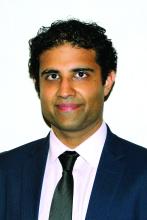User login
Pulmonary Vascular & Cardiovascular Network
Cardiovascular Medicine and Surgery Section
Sepsis and septic shock still carry high morbidity and mortality in ICU patients despite recent improvements in care. Sepsis-induced cardiomyopathy (SICM), which complicates greater than 10% of sepsis and septic shock cases, carries a worse prognosis and is often underrecognized. Unfortunately, no universal definition of SICM exists, making diagnosis and evaluation of novel therapeutic options difficult. Initially described in the 1980s, common fundamental features of SICM include an acute and reversible decline in LVEF with typical resolution in days to weeks; RV, LV, or BiV dysfunction; LV dilation; diminished response to fluid resuscitation or catecholamines; and absence of acute coronary syndrome (L’Heureux, Sternberg et al, 2020). A definition of SICM based solely on LVEF is incomplete due to its reliance on cardiac loading conditions. Diagnostic advances using pulse contour analysis and echocardiographic measure of longitudinal strain hold promise in better characterizing cardiac dysfunction in sepsis (Beesley et al, 2018). SICM should further be distinguished from stress-induced cardiomyopathy or Takotsubo cardiomyopathy, which can also complicate cases of sepsis and is characterized by regional wall motion abnormalities, classically LV apical ballooning with preserved contractility of the basal segments. A movement toward a standard definition of SICM would allow a more rigorous evaluation of risk factors and future directions for therapy, including a potential role for mechanical circulatory support in patients who fail to improve with inotropic support.
Looking for more information on sepsis? Visit CHEST’s Sepsis Topic Collection Page at chestnet.org/Topic-Collections/Sepsis for research, infographics, and more developed by the CHEST Sepsis Resources Steering Committee.
Tarun Kapoor, MD: Section Fellow-in-Training
Andrew Petrilli, MD
Pulmonary Vascular & Cardiovascular Network
Cardiovascular Medicine and Surgery Section
Sepsis and septic shock still carry high morbidity and mortality in ICU patients despite recent improvements in care. Sepsis-induced cardiomyopathy (SICM), which complicates greater than 10% of sepsis and septic shock cases, carries a worse prognosis and is often underrecognized. Unfortunately, no universal definition of SICM exists, making diagnosis and evaluation of novel therapeutic options difficult. Initially described in the 1980s, common fundamental features of SICM include an acute and reversible decline in LVEF with typical resolution in days to weeks; RV, LV, or BiV dysfunction; LV dilation; diminished response to fluid resuscitation or catecholamines; and absence of acute coronary syndrome (L’Heureux, Sternberg et al, 2020). A definition of SICM based solely on LVEF is incomplete due to its reliance on cardiac loading conditions. Diagnostic advances using pulse contour analysis and echocardiographic measure of longitudinal strain hold promise in better characterizing cardiac dysfunction in sepsis (Beesley et al, 2018). SICM should further be distinguished from stress-induced cardiomyopathy or Takotsubo cardiomyopathy, which can also complicate cases of sepsis and is characterized by regional wall motion abnormalities, classically LV apical ballooning with preserved contractility of the basal segments. A movement toward a standard definition of SICM would allow a more rigorous evaluation of risk factors and future directions for therapy, including a potential role for mechanical circulatory support in patients who fail to improve with inotropic support.
Looking for more information on sepsis? Visit CHEST’s Sepsis Topic Collection Page at chestnet.org/Topic-Collections/Sepsis for research, infographics, and more developed by the CHEST Sepsis Resources Steering Committee.
Tarun Kapoor, MD: Section Fellow-in-Training
Andrew Petrilli, MD
Pulmonary Vascular & Cardiovascular Network
Cardiovascular Medicine and Surgery Section
Sepsis and septic shock still carry high morbidity and mortality in ICU patients despite recent improvements in care. Sepsis-induced cardiomyopathy (SICM), which complicates greater than 10% of sepsis and septic shock cases, carries a worse prognosis and is often underrecognized. Unfortunately, no universal definition of SICM exists, making diagnosis and evaluation of novel therapeutic options difficult. Initially described in the 1980s, common fundamental features of SICM include an acute and reversible decline in LVEF with typical resolution in days to weeks; RV, LV, or BiV dysfunction; LV dilation; diminished response to fluid resuscitation or catecholamines; and absence of acute coronary syndrome (L’Heureux, Sternberg et al, 2020). A definition of SICM based solely on LVEF is incomplete due to its reliance on cardiac loading conditions. Diagnostic advances using pulse contour analysis and echocardiographic measure of longitudinal strain hold promise in better characterizing cardiac dysfunction in sepsis (Beesley et al, 2018). SICM should further be distinguished from stress-induced cardiomyopathy or Takotsubo cardiomyopathy, which can also complicate cases of sepsis and is characterized by regional wall motion abnormalities, classically LV apical ballooning with preserved contractility of the basal segments. A movement toward a standard definition of SICM would allow a more rigorous evaluation of risk factors and future directions for therapy, including a potential role for mechanical circulatory support in patients who fail to improve with inotropic support.
Looking for more information on sepsis? Visit CHEST’s Sepsis Topic Collection Page at chestnet.org/Topic-Collections/Sepsis for research, infographics, and more developed by the CHEST Sepsis Resources Steering Committee.
Tarun Kapoor, MD: Section Fellow-in-Training
Andrew Petrilli, MD

